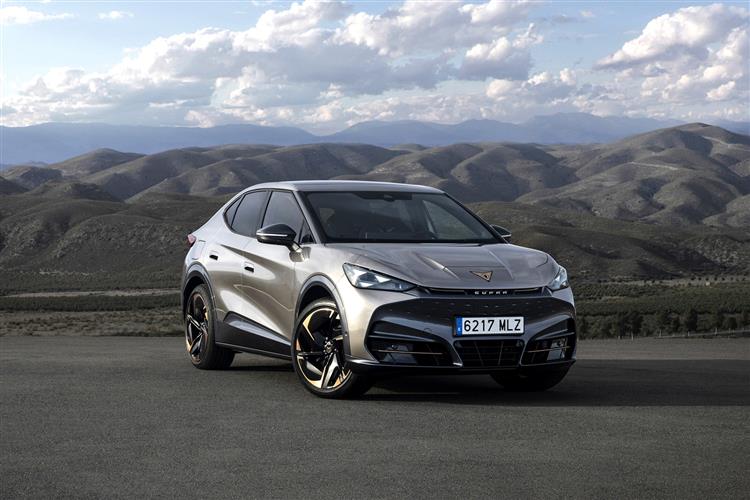SPANISH FLY (some text hidden) --NONE--
By Jonathan Crouch
The stylish Tavascan is a slightly larger kind of CUPRA EV crossover. Jonathan Crouch takes a look.
Ten Second Reviewword count: 38
CUPRA's third unique design, the Tavascan, takes this growing Spanish brand into an EV market segment for slightly larger models. And does so with a real splash of Iberian flare that effectively masks the shared VW Group underpinnings.
Backgroundword count: 194
We're fairly used to the CUPRA formula by now. Take an existing VW Group platform and its associated powertrains and sharpen up the looks and handling, before creating a more interestingly-trimmed cabin (usually with some copper-coloured bits). This approach worked like a charm in creating the compact CUPRA Born EV from a Volkswagen ID.3. Can it be as effective in the next EV class up, where this CUPRA Tavascan borrows just about everything you can't see from a mid-sized Volkswagen ID.4 (as well as from a Skoda Enyaq and an Audi Q4 e-tron). The Tavascan, launched in mid-2024, was a long time coming - the concept car of the same name dates all the way back to 2019. Following which CUPRA had to work out where to build it (exclusively in China as it turned out). This car is billed as 'a new era' for the brand, though we were also told that about the company's previous two models, that Born EV and the combustion-powered Formentor. But this is the largest and most ambitious CUPRA yet. Good enough to tempt you where an equivalent Volkswagen, Skoda or Audi EV might not? Let's find out.
Engines and Tech Specword count: 265
Though this Tavascan was launched a long time after its VW Group rivals, that doesn't mean it benefits from the Wolfsburg conglomerate's very latest EV engineering. Instead of the sophisticated 79kWh battery that would have delivered, what's served up here is the usual 77kWh battery you might be familiar with from an ID.4, an Enyaq or a Q4 e-tron. It energises two very different Tavascan variants; a rear-driven single motor entry-level model with 286PS good for 352 miles of range. Or a dual motor all wheel drive VZ derivative with 340PS and 324 miles of range. So far, so familiar. But CUPRA's engineers went to great trouble to differentiate the drive experience end result. Primarily in creating a much more feelsome steering rack and extensively tuning the MacPherson strut front and multi-link rear suspension, which gets recalibrated spring and damper rates and can be embellished with optional DCC adaptive dampers. There's more drive setting differentiation too, the options ranging from 'Comfort' to 'Range', 'Performance' and all-out 'CUPRA' mode (which gets its own button on the steering wheel). There's an argument for preferring the handling purity of the rear driven base model (it does after all carry around 100kgs less weight) but if budget permits, it might be difficult to ignore the sheer grunt of the top twin motor VZ. It sprints to 62mph in just 5.5s through the turns and up to 30% of power can be transferred to the front wheels for enhanced traction. The top speed of both models is limited to 112mph. Regenerative braking is controlled via paddles behind the steering wheel.
To see the full road test text contact us on 0330 0020 227
Pictures (high res disabled)

.jpg)
|
.jpg)
|
.jpg)
| |||
.jpg)
|
.jpg)
|
.jpg)
| |||
.jpg)
|
.jpg)
|
.jpg)
| |||
.jpg)
|

|
Statistics (subset of data only)
Min |
Max |
|
Price: |
£47,340.00 (At 28 Aug 2024) |
£60,835.00 (At 28 Aug 2024) |
Max Speed (mph): |
112 (VZ) |
|
0-62 mph (s): |
6.8 (V1) |
5.5 (VZ) |
Electric WLTP-Rated Driving Range (miles): |
352 |
|
Length (mm): |
4644 |
|
Height (mm): |
1861 |
|
Boot Capacity (l): |
540 |
|
Torque (lb ft): |
545 |
|



